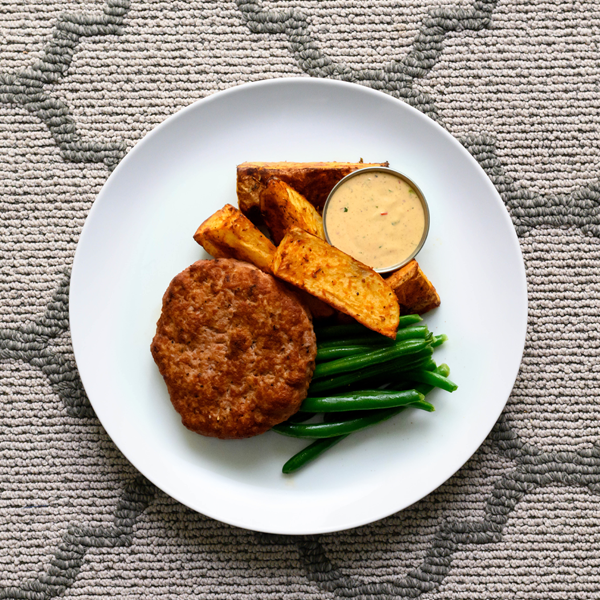In this article, we:
- define macronutrients
- explain how counting macros is different than just counting calories
- uncover how and why to spread out your macros and calories throughout the day
- show you how to craft a custom meal plan of your own to meet your goals and live a healthy lifestyle (because to achieve lasting change and results, you have to make this stuff a habit.)
Macronutrients: Not Just Calories
Macronutrients are just that...macro, meaning large. They are the large nutrients that make up our food and that our bodies need each day for energy. The other type of nutrient is a micronutrient, micro referring to small nutrients we need each day, including vitamins and minerals in our food. In this article we’re going to focus on macronutrients as they are the sole sources of energy for the body and will cover micronutrients at a later time.
You may have heard of someone “tracking their macros” or “counting calories.” These are not quite the same thing. Technically speaking, a calorie (kcal) is the energy needed to raise 1 kilogram of water through 1 degree celsius. The calories in our food provide energy to the body in order to carry out daily functions.
Not all calories are the same though, as they are organized into the three main macronutrients. Each macronutrient provides the body with a different type of energy, different benefits, and is metabolized differently. There are three main macronutrients: carbohydrates, protein, and fat.
|
Macronutrient |
Carbohydrates |
Protein |
Fat |
|
Energy provided to the body |
4 kcal/g |
4 kcal/g |
9 kcal/g |
|
Benefits |
provide quick energy to the body |
Build and repair muscle, sustain energy |
Unsaturated: protect against heart disease, brain and eye health, slows digestion Saturated: cell membrane and hormone function |
|
Best types to consume |
Complex, slow digesting, low glycemic index, high fiber (whole grains, fruit with skin on, vegetables, legumes) |
Lean, hormone and antibiotic free (poultry, fish, lean red meats, eggs, yogurt, beans/legumes for plant based eaters) |
Choose unsaturated (fish, eggs, olive oil, avocado, nuts) Saturated in moderation (animal sources of fat - red meats, cheese, butter) |
|
Types to avoid |
Simple, refined, processed, quick digesting (pretty much anything white) |
Highly marbleized meats that contain large amounts of saturated fat |
Trans: increase risk for heart disease, decrease HDL, increase LDL (fried foods, baked goods, pastries, anything that can sit on a shelf for a long time) |
|
Portion of daily intake |
30-60% |
25-40% |
25-35% |
Carbohydrates provide 4 kcals per gram to the body. This means that for every gram of carbohydrate you consume, you’re giving your body 4 units (calories) of energy. Always consume complex, low glycemic index carbohydrates that are full of fiber, digest slowly, and keep insulin levels normalized. According to the Academy of Nutrition and Dietetics, carbohydrates should comprise 30-60% of your daily caloric intake.
Protein also provides 4 kcals per gram. We want to consume lean, high quality proteins as well, particularly those that are hormone and antibiotic free and fed a naturally occurring diet raised in open living conditions. For plant based eaters, choose high quality seeds and legumes paired to form a complete amino acid profile. Protein should comprise 25-40% of your daily intake.
Fats are more than double nutrient dense as protein carbs; they are 9 kcals per gram. These calories can add up very quickly just in a small amount. (Take a look at our Hand Portions Guide for how much fat you should really be having for one serving. Those handfuls of nuts are packing a larger caloric punch than you may think). Fats should make up 25-35% of your daily intake.
Having noted these nutritional differences, consuming simply the amount of calories needed, leaving one or more macronutrient out, will inhibit us from reaching our goals. Therefore, it is important to make sure we pay attention to the types of calories we are consuming.
How to Balance Calories Throughout the Day
The most important part of figuring out how to consume the calories your body needs throughout the day is consistency. Regardless of what you do (3 meals a day, 5 meals a day, 2 meals a day with snacks) you have to find something you can do consistently over time to see results. All of the examples we provide below work, but they do not work for every person. We all have different schedules and thus our eating patterns are all going to be slightly different.
I know you want us to divulge the perfect eating pattern and top secret to losing weight and living a kick ass, worry free healthy lifestyle, but I regret to inform you that such a perfect plan does not exist and will never exist. However, YOUR perfect plan is out there, you just have to do a bit of strategic planning and experimentation to discover it.
In general, most people see amazing metabolic results when they spread out their calories across the day. This translates to eating 5-6 smaller meals and/or snacks across all of your waking hours.
This helps primarily in three ways:
- Eating consistently throughout the day means you won’t be starving at the end of the day and will help you refrain from binge eating later in the evening. Binge eating is a great way to over-consume because your body typically goes for sugary, fatty foods to provide the quickest energy possible to continue functioning .
- Smaller, more frequent meals help control and maintain insulin levels and blood amino levels. This keeps the body in an anabolic (muscle building) state rather than a catabolic (muscle breakdown) state. You’ll also have more consistent energy levels throughout the day with no crashing effect after larger, more dispersed meals.
- Eating smaller, more frequent meals throughout the day increases metabolism because our bodies always have something to burn.
As mentioned earlier, there is no one perfect way to spread out your meals. Spread out meals in a way that works for YOUR lifestyle/schedule (i.e. if you can only have 3 meals per day because of your schedule THAT IS OK. It’s way better than not eating at all during the morning and then binge eating at the end of the day, and is it working WITH your lifestyle)
|
6AM |
6:30AM |
9:30AM |
12:30PM |
3:30PM |
6:30PM |
8:30PM |
11PM |
|
Wake up |
Breakfast |
Snack #1 |
Lunch |
Snack #2 |
Dinner |
Snack #3 |
Bed |
In this example, this person is eating roughly every 3 hours. The meals and snacks are spread out evenly across all waking hours. This is going to be different for every person and dependent upon when you wake up, when you go to bed, and what your work schedule will allow for.
Determining Caloric Needs
Balance
Balance applies not only to eating timely throughout the day (every 3-ish hours), but this also affects your the quantity of food you eat and portion sizes. Smaller, more frequent meals mean that you are going to consume smaller portions of food. This may be an adjustment if you’re used to eating very large, infrequent meals.
As we saw in the example above, we want to spread out calories equally throughout the day. Rather than having a 500 calorie breakfast, 700 calorie lunch, and 300 calorie dinner, aim to make your meals consist of approximately equal calorie amounts (it’s not going to be perfectly the same for every meal so don’t stress!).
How to determine how many calories YOU should eat:
First and foremost, because this is a very common misconception, LESS CALORIES DOES NOT MEAN YOU WILL LOSE WEIGHT. Remember that food is fuel for our bodies. Our bodies need fuel to burn off excess calories. Starving your body will have the opposite effect may result in some weight loss short term but will absolutely have adverse effects long term, and we want to build habits that are sustainable to achieve lasting change.
Different people require different calorie amounts. Caloric needs vary based on gender, age, and activity level.
Overall though, if you are trying to lose weight you need to burn more calories than you consume and if you’re trying to gain weight you need to consume more calories than you burn. This is often referred to as input v. output: it doesn’t matter what your macronutrient breakdown is; if you are putting more energy IN and not enough OUT you will store fat.
|
“I want to lose weight” |
Calories In |
< |
Calories Out |
|
“I want to gain weight” |
Calories In |
> |
Calories Out |
Examples:
1500 kcal diet per day
Breakfast, Lunch, Dinner = 350 - 400 kcals (you’ll see how we got this in just a sec)
Snacks (remember that how many you eat depends on what YOU determine to work best for YOUR schedule)
2 snacks = 150-200 kcals
3 snacks = 100-150 kcals
What this looks like during the day:
|
6AM |
6:30AM |
9:30AM |
12:30PM |
3:30PM |
6:30PM |
8:30PM |
10:30PM |
|
Wake up |
Breakfast |
Snack #1 |
Lunch |
Snack #2 |
Dinner |
Snack #3 |
Bed |
|
350-400 kcals |
100-150 kcals |
350-400 kcals |
100-150 kcals |
350-400 kcals |
100-150 kcals |
There is no one size fits all way to eat. Experiment and find what works best for you. For help help creating your custom meal plan with appropriate macronutrient breakdown along with meal timing, contact Allison.
2400 kcal diet per day
Breakfast, Lunch, Dinner = 600 kcals
Snacks
2 snacks = 300 kcals
3 snacks = 200 kcals
|
6AM |
6:30AM |
9:30AM |
12:30PM |
3:30PM |
6:30PM |
10:30PM |
|
Wake up |
Breakfast |
Snack #1 |
Lunch |
Snack #2 |
Dinner |
Bed |
|
600 kcals |
300 kcals |
600 kcals |
300 kcals |
600 kcals |





